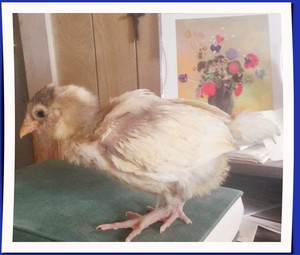16 Jul Sat 2016
The chantecler died
Yesterday, my last Chantecler, a partridge hen, died. She had not been laying in a while, since last summer, but we kept her around for winter: Chants are great winter birds and though the Almanack said it would not be nearly as cold as the past 2, having an extra hen to generate heat in a cold coop, does not hurt.
She was a great brood mother. Unfortunately, she had a black cap on her head, which I was told by the Club Founder, Mike Gilbert, was not APA accepted. Pity, I liked that look at lot; I think that was a mistake. Still that was the case, so what can you do; she never went a show room but stayed on the farm, and was happy.
This year she was in her glory. She would go around cluck and worry about her chicks, all buff Ameraucanas, and look after the 25 counting heads and making sure they were all there. Some of them got culled early on because they had crooked or scissor beaks. When I killed them, she would scream and look for them and then huddle the survivors under her broad wings for protection.
I have had camera problems lately, but that's a poor excuse honestly. I have no pictures of her, and I was sorry to see her dead, in her tractor home alone. I don't know what killed her, but last week others of her age, she was three, died as well. Pity they died rather young; some people I know have hens forever, almost literally, mine basically from hatcheries have not lasted so long. Makes it rough to build up stock.
The page attached is from the Livestock Conservancy Book, which is somewhat better than their website but not much. The partridge Chanteclers unlike the whites, are from Alberta. They are very broody.
She was a great brood mother. Unfortunately, she had a black cap on her head, which I was told by the Club Founder, Mike Gilbert, was not APA accepted. Pity, I liked that look at lot; I think that was a mistake. Still that was the case, so what can you do; she never went a show room but stayed on the farm, and was happy.
This year she was in her glory. She would go around cluck and worry about her chicks, all buff Ameraucanas, and look after the 25 counting heads and making sure they were all there. Some of them got culled early on because they had crooked or scissor beaks. When I killed them, she would scream and look for them and then huddle the survivors under her broad wings for protection.
 |
| Cornish partridge female. My chantecler female with the black head was similar but the eyes were not as prominent and of course the comb was a cushion. |
The page attached is from the Livestock Conservancy Book, which is somewhat better than their website but not much. The partridge Chanteclers unlike the whites, are from Alberta. They are very broody.

Suki
07:55 PM EDT
The importance of a breeding plan
A friend of mine, Ike, has a great breeding plan for his lavender Ameraucanas, but, and this is the hilarious part, somewhere along the line, he lost track of it, and starting breeding lavenders with white beaks. He thinks what happened, and his guess is as good as yours and mine, is that he got blinded by the colour of the bird and the legs of the bird and never noticed the beaks. So this spring he hatched 100 lavender chicks. An incredible amount but when you have a 1502 you can do that in a heart beat, if you store them waiting for incubation properly, and now they are 6 weeks old and eating like beavers, but they all have white beaks. Beautiful looking but with the beak wrong, a loss. So I recommended selling them at his auction house like he typically does, but and here's the rub, they are so pretty otherwise, he's worried someone will get them for a song. And that's why its important to write down a checklist of what to look for so you can write off each feature and know you are still on plan.
Since I haven't been breeding Ameraucanas very long, I tend not to rely on memory, but I review the standard and my "reference" pictures quite often. This Spring though has been a brutal hatching season, and out of the 20 black Ameraucanas I hatched, two or about 10%, I think, are what I'm looking for...that's not counting all the eggs that did not work because my boys weren't plucked enough and so the eggs were infertile. Obviously that was not, at the time, in the plan.

Suki
07:54 PM EDT

